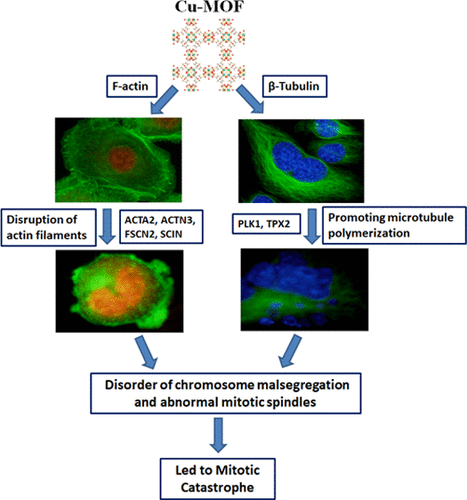当前位置:
X-MOL 学术
›
ACS Appl. Bio Mater.
›
论文详情
Our official English website, www.x-mol.net, welcomes your
feedback! (Note: you will need to create a separate account there.)
Pristine Cu-MOF Induces Mitotic Catastrophe and Alterations of Gene Expression and Cytoskeleton in Ovarian Cancer Cells
ACS Applied Bio Materials ( IF 4.6 ) Pub Date : 2020-06-23 , DOI: 10.1021/acsabm.0c00175 Daomei Chen 1, 2 , Bin Li 2 , Liang Jiang 1, 3 , Yizhou Li 1, 3 , Yepeng Yang 1, 3 , Zhifang Luo 1, 3 , Jiaqiang Wang 1, 3
ACS Applied Bio Materials ( IF 4.6 ) Pub Date : 2020-06-23 , DOI: 10.1021/acsabm.0c00175 Daomei Chen 1, 2 , Bin Li 2 , Liang Jiang 1, 3 , Yizhou Li 1, 3 , Yepeng Yang 1, 3 , Zhifang Luo 1, 3 , Jiaqiang Wang 1, 3
Affiliation

|
Metals–organic frameworks (MOFs) have been widely explored in biomedicine, mostly in drug delivery, biosensing, and bioimaging due to their large surface area, tunable porosity, readily chemical functionalization, and good biocompatibility. However, the underlining cellular mechanisms controlling the process for MOF cytotoxicity remains almost completely unknown. Here, we demonstrate that pristine Cu-MOF without any loaded drug selectively inhibited ovarian cancer mainly through promoting tubulin polymerization and destroying the cell actin cytoskeleton (F-actin) to trigger the mitotic catastrophe, accompanying by conventional programmed cell death. To our knowledge, this is the first report claiming that mitotic catastrophe may be an explaining mechanism of MOF cytotoxicity. Cu-MOF with an intrinsic protease-like activity also hydrolyzed cellular cytoskeleton proteins (F-actin). The RNA sequencing data indicated the differential expressional mRNA of cell proliferation and actin cytoskeleton (ACTA2, ACTN3, FSCN2, and SCIN) and mitotic spindles (PLK1 and TPX2) related genes. We found that Cu-MOF as a promising candidate in the disruption of cellular cytoskeleton and the change of the gene expression could be actin altering and antimitotic agents against cancer cells, allowing for fundamental biological and biophysical studies of MOFs.
中文翻译:

原始 Cu-MOF 在卵巢癌细胞中诱导有丝分裂灾难和基因表达和细胞骨架的改变
金属-有机框架 (MOF) 在生物医学中得到了广泛的探索,主要用于药物递送、生物传感和生物成像,因为它们具有大的表面积、可调节的孔隙率、易于化学功能化和良好的生物相容性。然而,控制 MOF 细胞毒性过程的细胞机制仍然几乎完全未知。在这里,我们证明了没有任何负载药物的原始Cu-MOF主要通过促进微管蛋白聚合和破坏细胞肌动蛋白细胞骨架(F-肌动蛋白)来触发有丝分裂灾难,伴随着常规的程序性细胞死亡,从而选择性地抑制卵巢癌。据我们所知,这是第一份声称有丝分裂灾难可能是 MOF 细胞毒性的解释机制的报告。具有内在蛋白酶样活性的 Cu-MOF 也水解细胞骨架蛋白(F-肌动蛋白)。RNA测序数据表明细胞增殖和肌动蛋白细胞骨架(ACTA2、ACTN3、FSCN2和SCIN)和有丝分裂纺锤体(PLK1和TPX2)相关基因的差异表达mRNA。我们发现,Cu-MOF 作为破坏细胞骨架和改变基因表达的有希望的候选者,可能是肌动蛋白改变剂和抗癌细胞的抗有丝分裂剂,从而可以对 MOF 进行基础生物学和生物物理研究。
更新日期:2020-07-20
中文翻译:

原始 Cu-MOF 在卵巢癌细胞中诱导有丝分裂灾难和基因表达和细胞骨架的改变
金属-有机框架 (MOF) 在生物医学中得到了广泛的探索,主要用于药物递送、生物传感和生物成像,因为它们具有大的表面积、可调节的孔隙率、易于化学功能化和良好的生物相容性。然而,控制 MOF 细胞毒性过程的细胞机制仍然几乎完全未知。在这里,我们证明了没有任何负载药物的原始Cu-MOF主要通过促进微管蛋白聚合和破坏细胞肌动蛋白细胞骨架(F-肌动蛋白)来触发有丝分裂灾难,伴随着常规的程序性细胞死亡,从而选择性地抑制卵巢癌。据我们所知,这是第一份声称有丝分裂灾难可能是 MOF 细胞毒性的解释机制的报告。具有内在蛋白酶样活性的 Cu-MOF 也水解细胞骨架蛋白(F-肌动蛋白)。RNA测序数据表明细胞增殖和肌动蛋白细胞骨架(ACTA2、ACTN3、FSCN2和SCIN)和有丝分裂纺锤体(PLK1和TPX2)相关基因的差异表达mRNA。我们发现,Cu-MOF 作为破坏细胞骨架和改变基因表达的有希望的候选者,可能是肌动蛋白改变剂和抗癌细胞的抗有丝分裂剂,从而可以对 MOF 进行基础生物学和生物物理研究。











































 京公网安备 11010802027423号
京公网安备 11010802027423号